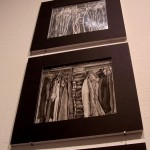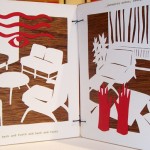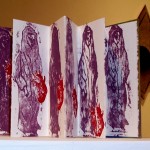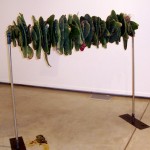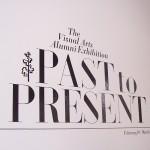“Past to Present,” Idyllwild Arts’ alumni arts exhibition, ends today, Friday, March 2 at the Parks Exhibition Center on campus. Although most of the hoopla of the show was focused on Shepard Fairey’s work (’88), there were 19 other alumni artists in the show.
Yesterday, five of the artists from the show (who live in Idyllwild) participated in a panel discussion whose topic was, “Making Art After School: Creating Art as a Lifelong Pursuit.” Daniel Gray, Erin Latimer, Alison Yates, Paul Waddell and Youree Jin all work at the academy and fielded questions from students and faculty at 3:30 p.m. at the Parks Exhibition Center.
“Three weeks ago, the opening was so packed that it was hard to talk to the artists,” said Mallory Cremin, who curated the show.
She said that she was sorry that Jonathan Taube and Tada Kono (both from ’06) left without talking much about their work. Their work from WIKI Studio featured two installations of organic materials. “Chametz Roulette” featured loaves of bread “That may nor may not contain mortal shrapnel.” Loaves were $11.99 each.
Taube and Kono’s other installation, “Within Limbo,” featured pieces of prickly pear cactus attached to a pole.
“Each cactus is intended to be a collectible living object,” the pair wrote in the information about the show. “They are for sale for $6 each.”
When Mallory opened the gallery several days before the end of the show, several of the cacti had rotted and fallen from the pole.
“This is not part of the installation,” Mallory said, as she scooped up the debris.
Since the students didn’t get to speak with Kono and Taube, Mallory said that she wanted to give the local artists the opportunity to speak about their work before the show ended today.
Erin Latimer (’02) and Alison Yates (’03) both showcased artist books. Erin’s books were small and portable (3 x 3 inches and 2 x 5 inches). “Mythology” and “Refugee. Evacuee. Survivor,” featured linobloc prints.
The images depict a profile of a woman with an oversized heart falling down to her feet. She is shrouded, so it could depict a Middle Eastern woman’s plight, or it could depict an American woman, for example, who is “cloaked” in darkness?
It could also be telling a story about work or even love relationships.
Alison’s artist’s book title, “Housework,” was understated. It was actually wonderfully crafted paper cuts on wood panels. The palette of her paper cuts was limited to only three colors, red, black and white. Which was telling because they are the colors of ashes, fire and smoke.
Note that she used uniform square wood panels as pages for her art book. Threads loosely bound them.
“Sweeping crumbs or sweeping ashes,” was the text that Alison repeated on several panels, yet her compelling images in red, white and black showed a housewife going from brushing up crumbs to turning into toast.
On one of the panels, Alison asks, “Was it intentional?”
The threat of fire is part of the Idyllwild fabric, even for the students who live on campus. Matches are banned from the dorm rooms. You can’t even light candles on a birthday cake. Hopefully, during the panel discussion yesterday some of the students asked Alison if her art book told a true story?
Youree Jin’s installation of small, framed etchings of “Closet,” showcased how she took one image and used various materials, including glass, paper, fabric, ink and thread, to create totally different effects. Some looked like collages, while others looked like x-ray negatives (if that’s possible!) of a closet!
More text to come
the attachments to this post:





